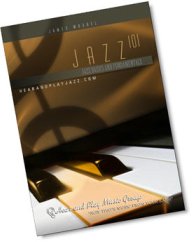Extended Chords
7th - 9th - 11th - 13th
Extended chords (or higher numbered chords) have notes in addition to the basic triad. These are called extensions... i.e. 7th, 9th, 11th, 13th.
Here are the basic guidelines regarding extended chords:
- 7th = triad + 7th
- 9th = triad + 7th + 9th
- 11th = triad + 7th + 9th + 11th
- 13th = triad + 7th + 9th + 11th + 13th
There are other guidelines and rules of the road regarding extended chords. Look at the following examples will point out.
the 7th Chord
This is how a C7 chord stacks up:
There is a C major triad + a 7th (minor 7th)

More chord extensions follow below: the 9th, 11th and 13th.

Discover:
- How to overcome fear when it comes to improvising and learn what it takes to play runs, licks, and solos with ease.
- How to use the same exact systemprofessional musicians use to solo with comfort and precision over any chord progression.
- How to avoid making the mistakes most musicians make when it comes to improvising and playing the right ideas over common chords.
- How to shortcut your way to professional status and sound amazing on the piano without years of training.
the 9th Chord
To get the correct letter name of the chord member, or extension, just count up,line - space - line - etc. till you get to the next extension.
Counting up from the 7th, first extended chord is the 9th. This is how a C9 chord stacks up:
there is a C major triad + a 7th + a 9th (major 9th)...
or, C - E - G - Bb - D

A complete 9th chord has 5 notes. They can be divided with the root in a bass instrument (or left hand) and the other notes inverted in a treble instrument (or right hand).
Note: a 9th is the same as a 2nd, just an 8va higher - so diatonic 2nds & 9ths are major.

the 11th Chord
Next, counting up from the 9th, we go to the 11th. This is how a C11 chord stacks up:
there is a C major triad + a 7th + a major 9th + a perfect 11th
Note: an 11th is the same as a 4th, just an 8va higher - so diatonic 4ths & 11ths are perfect.

RULE: 11th chords always (well, 99.9% of the time) eliminate the 3rd. The sound of the 3rd would clash very badly with the 11th (try it), so it is left out!
A C11 would be C - G - Bb - D - F
A C11 is sometimes referred to as a Gm7/C.

the 13th Chord
Counting up stepwise from the 11th, we go to the 13th. This is how a C13 chord stacks up:
there is a C major triad + a 7th + a 9th + an 11th + a perfect 13th
Note: a 13th is the same as a 6th, just an 8va higher - so diatonic 6ths & 13ths are perfect.

RULE: 13th chords usually eliminate the 5th & 11th
A C13 would be C - E - Bb - D - A

A similar version might eliminate the 3rd & 5th like this...
C13(add11) = C - Bb - D - F - A
more commonly referred to as a Bbmaj7/C

7th chords - chord inversions - sus chords
extended chords - diatonic triads - diatonic 7th chords
primary chords - secondary chords - secondary dominants

Click here to GO BACK TO CHORDS & TRIADS
THE COMPLETE
ONLINE BUSINESS BUILDER
SBI
Hi and Welcome!
Fill out the form below to sign up for the free periodic
Player's Guide Newsletter!
Get tips and ideas about substitute chords, chord progressions and harmonic movement.
What's this???
Harmony and Theory:
by Carl Schroeder and Keith Wyatt
Download intervals
The Complete book of:
Scales, Chords,
Arpeggios & Cadences





